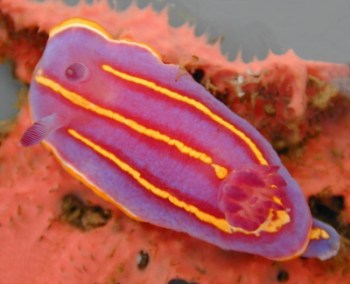
Chromodoris macfarlandi
Cockerell, 1902
Order: NUDIBRANCHIA
Suborder: DORIDINA
Superfamily: EUDORIDOIDEA
Family: Chromodorididae
DISTRIBUTION
Monterey Bay, California to Baja California, Mexico.
PHOTO
24 mm long specimen on food sponge Aplysilla glacialis. Bird Rock, La Jolla, California. PHOTO: Jeff Goddard.
Characterised by its violet colour and three yellow longitudinal lines on the mantle. grows to about 40mm. See Jeff Goddard's message below on feeding.
Reference:
• Cockerell, T.D.A. (1902) Three new species of Chromodoris. The Nautilus 16(1): 19-21.
Rudman, W.B., 2000 (June 4) Chromodoris macfarlandi Cockerell, 1902. [In] Sea Slug Forum. Australian Museum, Sydney. Available from http://www.seaslugforum.net/find/chromacf
Related messages
Chromodoris macfarlandi from California coast
February 7, 2007
From: Ken Tucker
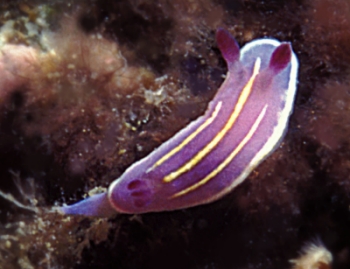
I found this one in my files. Unfortunately, all I know is that it was photographed in the US Channel Islands sometime in the mid-1990s.
As it's a reasonable photo, and a bit different than others in the thread, I thought it might be of interest.
Locality: Channel Islands, California, USA, Pacific Ocean, mid-1990s. Photographer: Ken Tucker.
Ken Tucker
ken@kilili.com
Tucker, K., 2007 (Feb 7) Chromodoris macfarlandi from California coast. [Message in] Sea Slug Forum. Australian Museum, Sydney. Available from http://www.seaslugforum.net/find/19382Hi Ken,
We have discovered some amazing thngs going through files lately, but I digress. Thanks for sharing.
Yes, this is Chromodoris macfarlandi. Actually it is pretty typical, considering the slide may have aged. Like most nudibranchs, this species exhibits quite some variability in color. I have documented specimens where the three longitudinal lines are even made up of collection of randomly sized specks and spots. Some specimens have a white marginal band and some do not. Three longitudinal yellow lines, purple gill and rhinophores, and you have C. macfarlandi
Thanks,
Dave Behrens
Chromodoris macfarlandi? from California
June 10, 2006
From: Josiah Renfree
I'm sorry that I don't have a picture, but I was hoping that a simple description would be enough. I went diving at the Anacapa island off the coast of California and saw a bunch of spanish shawls, but there was one nudibranch of which I have no idea what it is. It was really small, maybe about the size of a pen cap, and was blue with a single yellow stripe running length-wise across its body. That's about all the description I can give you, but hopefully that will suffice.
Locality: Island, 30 feet, California, USA, Pacific Ocean, 04 June 2006, Rocky bottom off the island of Anacapa. Length: 2 inches
Thanks!
Josiah Renfree
jrenfree@gmail.com
Renfree, J., 2006 (Jun 10) Chromodoris macfarlandi? from California. [Message in] Sea Slug Forum. Australian Museum, Sydney. Available from http://www.seaslugforum.net/find/16817Hi Josiah:
Wow..... you have provided us with a challenge. Because sea slugs are so diverse and variable it is very difficult to make an identification from a written description without a photo. As a matter of fact, often times we cannot be sure even with a photo.
That said, I am thinking (guessing) that your species was Chromodoris macfarlandi. This is the only species I can think of that lives in the waters of Anacapa Island and is sometimes blue and has a yellow mid-dorsal stripe.
With that hint, what do you think?
Dave Behrens
Mating Chromodoris macfarlandi
March 13, 2006
From: Kevin Lee
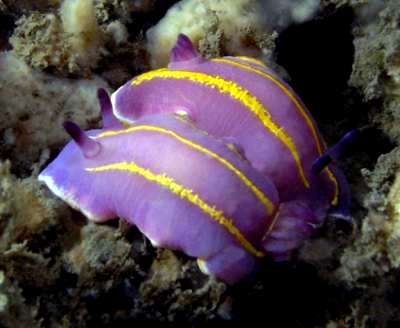
Hi Folks,
Just wanted to share, with you, a pair of mating Chromodoris macfarlandi.
K:-)
Locality: Scripp's Canyon, La Jolla Shores, approx. 75 feet, California, Eastern Pacific, 06 January 2006, Sandy wall. Length: approx. 1.5 inches. Photographer: Kevin Lee.
Kevin Lee
diverkevin@gmail.com
Lee, K., 2006 (Mar 13) Mating Chromodoris macfarlandi. [Message in] Sea Slug Forum. Australian Museum, Sydney. Available from http://www.seaslugforum.net/find/16104Thanks Kevin,
Bill Rudman
Chromodoris macfarlandi from California
July 28, 2005
From: Chris Grossman
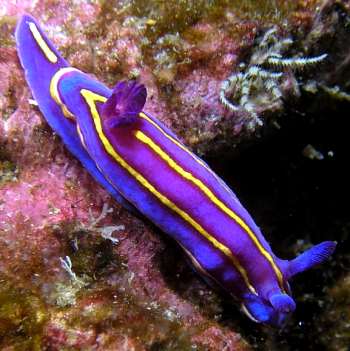
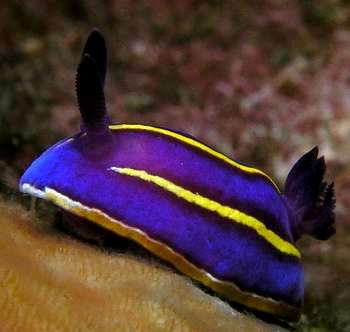
I took these images of Chromodoris macfarlandi at Ship Rock, Catalina Island, California, USA on July 15, 2005. The depth was about 17 meters. The two different ones here were found approximately 4 meters apart. They were just below the 15 meter thermocline in water of 12 ºC. It was my first time seeing this species.
Locality: Ship Rock, Santa Catalina Island, California, USA. Depth: 17 meters. Length: 6 cm and 4 cm. July 15, 2005. rocky with kelp. Photographer: Chris Grossman
All of the photos from that dive trip can be found here:
californiadiveboats.com/Peace/..../
Chris Grossman
seaslugforum.net@scubadiversnetwork.com
Grossman, P. C., 2005 (Jul 28) Chromodoris macfarlandi from California. [Message in] Sea Slug Forum. Australian Museum, Sydney. Available from http://www.seaslugforum.net/find/14430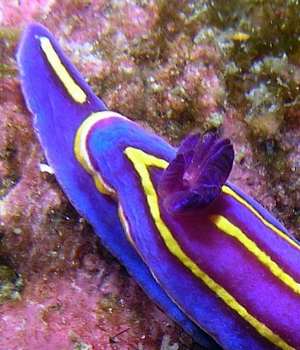
Dear Chris,
It's nice for you to have found two of the Californian 'blue chromodorids' at the same time [see message #14431 ]. Your photos show the distinctive white line, inside the yellow border of the mantle, That white line, and the three longitudinal yellow lines on the mantle, are a sure way to distinguish this species from the other Californian species. As I said with your photo of Mexichromis porterae, photos of this species feeding, or egg-laying would be very welcome
Best wishes,
Bill Rudman
Chromodoris macfarlandi from California
August 6, 2004
From: Bruce Wight
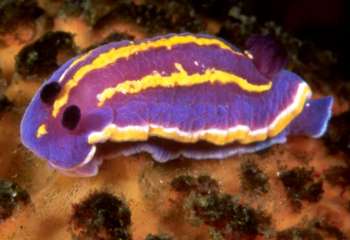
Hi guys,
Here is a photo of Chromodoris macfarlandi I took on our recent trip to San Miguel Island [Channel Ids, California] in July 2004.
Best wishes
Bruce Wight
bruce.c.wight@boeing
Wight, B, 2004 (Aug 6) Chromodoris macfarlandi from California. [Message in] Sea Slug Forum. Australian Museum, Sydney. Available from http://www.seaslugforum.net/find/12713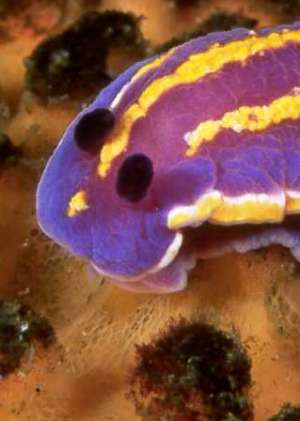
Thanks Bruce,
I guess it is on one of its food sponges, perhaps Aplysilla glacialis? It's remarkable how similar in colour it is to Mexichromis porterae, as illustrated in Chris Grossman's recent message [#12727].
Best wishes
Bill Rudman
Information on Chromodoris macfarlandi
February 12, 2002
From: Annalise Trepanier
Hello,
I am doing a project for school and I can not find a lot of information about the MacFarland's Chromodorid (Chromodoris macfarlandi). I wanted to know if you could send me some stuff on my animal.
Thanks,
Annalise Trepanier
soccerchic@oakharbor.net
Trepanier, A., 2002 (Feb 12) Information on Chromodoris macfarlandi. [Message in] Sea Slug Forum. Australian Museum, Sydney. Available from http://www.seaslugforum.net/find/6156Dear Annalise,
I don't know if we know too much about the life of Chromodoris macfarlandi. We have still a lot to learn about most marine animals. If you have a look at the Chromodoris macfarlandi Page you will find photos and some information in the messages on that page.
It feeds on two species of sponge, and like all chromodorids it can remove nasty chemicals from the sponges it eats and store them in special glands in its skin for its own defence. When fish, or other predators attempt to eat the slug they will get a mouthful of nasty chemicals. If you look at the pages listed on the Opisthbranch Defence page, in particular those to do with mimicry, defensive coloration and defensive glands, you will see that these animals are more than just a pretty face.
Their bright colours are part of an elaborate mechanism to warn fish that they should be left alone.
Perhaps someone can give us some more information, or reference to more information, on other aspects of their natural history.
Good luck with your project,
Bill Rudman
Chromodoris macfarlandi on Aplysilla polyraphis
June 13, 2000
From: Jeff Goddard
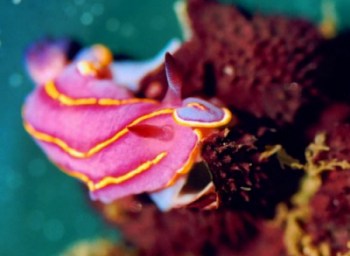
Hi Bill,
Here is a photo of a 22 mm long Chromodoris macfarlandi on a piece of its preferred prey, the sponge Aplysilla polyraphis. I found both at Bird Rock, La Jolla, California last weekend. The hair-like vertical spongin fibers are all that remain of the sponge after feeding by the nudibranch.
Regarding your question about variability in the color of the edge of the dorsum of Chromodoris macfarlandi, all of the twenty or so specimens I have seen have had the outer yellow and inner white bands. Only Behrens (1980) describes the edge as white. Behrens (1991), MacFarland (1966), McDonald & Nybakken (1980) and McDonald (1983) all describe the edge as being cadmium orange or yellow gold, with a submarginal band of white.
I am not familiar with any references to work on chromodorids acquiring color pigments from their prey, but I will do some searching. Based on the similarity of the color of Aplysilla polyraphis to the tips of both the gills and rhinophores of Chromodoris macfarlandi, I suspect this pair might be an example of such a transfer.
Jeff Goddard
goddard@lifesci.ucsb.edu
Goddard, J., 2000 (Jun 13) Chromodoris macfarlandi on Aplysilla polyraphis. [Message in] Sea Slug Forum. Australian Museum, Sydney. Available from http://www.seaslugforum.net/find/2561Dear Jeff,
Thanks for the photo to match your earlier one of C. macfarlandi feeding on Aplysilla glacialis [#2499].
Since asking about your suggestion of C. macfarlandi removing pigments from its food I have added some pages on Noumea haliclona which in some parts of its range is very cryptically coloured, but only on the right coloured sponge. From studies by Geoff Avern, we can say that in the case of the New South Wales colour form, the colour was independent of the colour of the food eaten.
Best wishes,
Bill Rudman
Sponge prey of Chromodoris macfarlandi
June 5, 2000
From: Jeff Goddard

Chromodoris macfarlandi was recently found to prey on two species of aplysillid sponges, the pink colored Aplysilla glacialis (shown here with a 24 mm long specimen of C. macfarlandi from Bird Rock, La Jolla, California) and the deep violet colored A. polyraphis (Goddard, 2000; Mahan, 2000). Field observations and a laboratory preference test (Goddard, 2000) suggest that C. macfarlandi prefer A. polyraphis to A. glacialis. Chromodoris macfarlandi may acquire its brilliant coloration from one or both of these species.
Feeding by Chromodoris macfarlandi on at least two species of aplysillid sponges previously had been inferred by Molinski & Faulkner (1986) based on two pieces of biochemical evidence. First, the structural similarity of secondary metabolites isolated from C. macfarlandi to ones previously isolated from an Australian aplysillid, Aplysilla sulphurea, and second, the differing ratios of these metabolites in different individuals of the nudibranch.
Previous references to Chromodoris macfarlandi feeding on the spiculate sponges, Gellius sp. and Haliclona sp. (Bloom, 1976; McDonald & Nybakken, 1978) are in error and actually apply to Hypselodoris californiensis (Bergh, 1879) (see McBeth, 1970, 1971).
References:
• Bloom, S. A. (1976) Morphological correlation between dorid nudibranch predators and sponge prey. The Veliger 18(3): 289-301.
• Goddard, J.H.R. (2000) Sponge prey of Chromodoris macfarlandi. Opisthobranch Newsletter 26(2): 9-10.
• Mahan, M. (2000) Field Notes. Opisthobranch Newslette,r 26(1): 1.
• McBeth, J.W. (1970) The deposition and biochemistry of carotenoid pigments in nudibranchiate molluscs. Ph.D. dissertation, University of California, San Diego.
• McBeth, J.W. (1971) Studies on the food of nudibranchs. The Veliger, 14(2): 158-161.
• McDonald, G.R. & J.W. Nybakken. (1978) Additional notes on the food of some California nudibranchs with a summary of known food habits of California species. The Veliger, 21(1): 110-119.
• Molinski, T.F. & D. J. Faulkner. (1986) Three new rearranged spongin diterpenes from Chromodoris macfarlandi: reappraisal of the structures of dendrillolides A and B. Journal of Organic Chemistry, 51: 4564-4567.
Jeff Goddard
goddard@lifesci.ucsb.edu
Goddard, J., 2000 (Jun 5) Sponge prey of Chromodoris macfarlandi. [Message in] Sea Slug Forum. Australian Museum, Sydney. Available from http://www.seaslugforum.net/find/2499Dear Jeff,
Thanks very much for the interesting observations on feeding in Chromodoris macfarlandi. Comparative and ecological studies on sponge feeding nudibranchs is greatly hampered by the difficulty in getting sponges correctly identified, especially when many look very similar to even the expert and confirmation requires mounting and examination of the spicules in spiculate species and spongin fibres and even biochemistry in those lacking spicules. It would certainly be interesting to check the sponges Hypselodoris californiensis feeds on because if it does feed on Haliclona it would be the first chromodorid I know of that does. I am afraid many sponges have been identified as "Haliclona" in the past, but few identifications stand a thorough examination. One classic example is a southeastern Australian species Noumea haliclona which will be cursed for all time with this name because its food was incorrectly identified as Haliclona. I am preparing some pages on this species at present in which I will show photos of it on a variety of species of aplysillid sponges, on which it feeds.
Have you any references to work on chromodorids acquiring colour pigments from their food sponges? Certainly some species, such as Noumea simplex and Verconia verconis, are very similar in colour to their food sponges, but that could be through colour selection rather than through the acquisition of prey pigments.
One other point I noticed was the bright outer yellow and white inner border to the mantle. Dave Behrens [Pacific Coast Nudibranchs (1980)] has a photo of an animal with only a white border. Is the yellow border variable?
Best wishes,
Bill Rudman.
